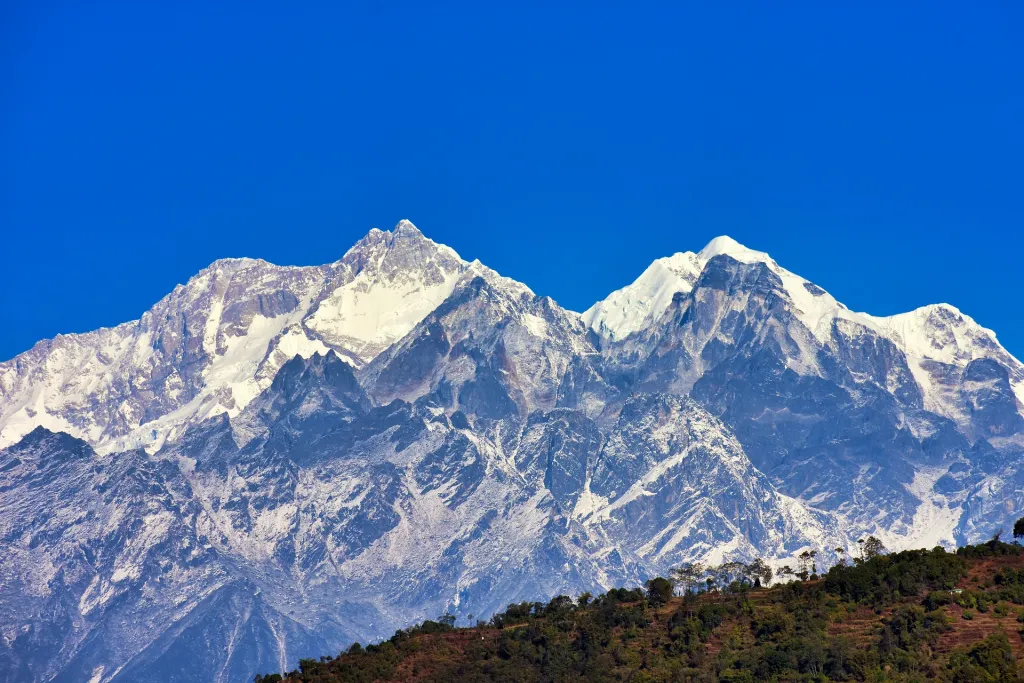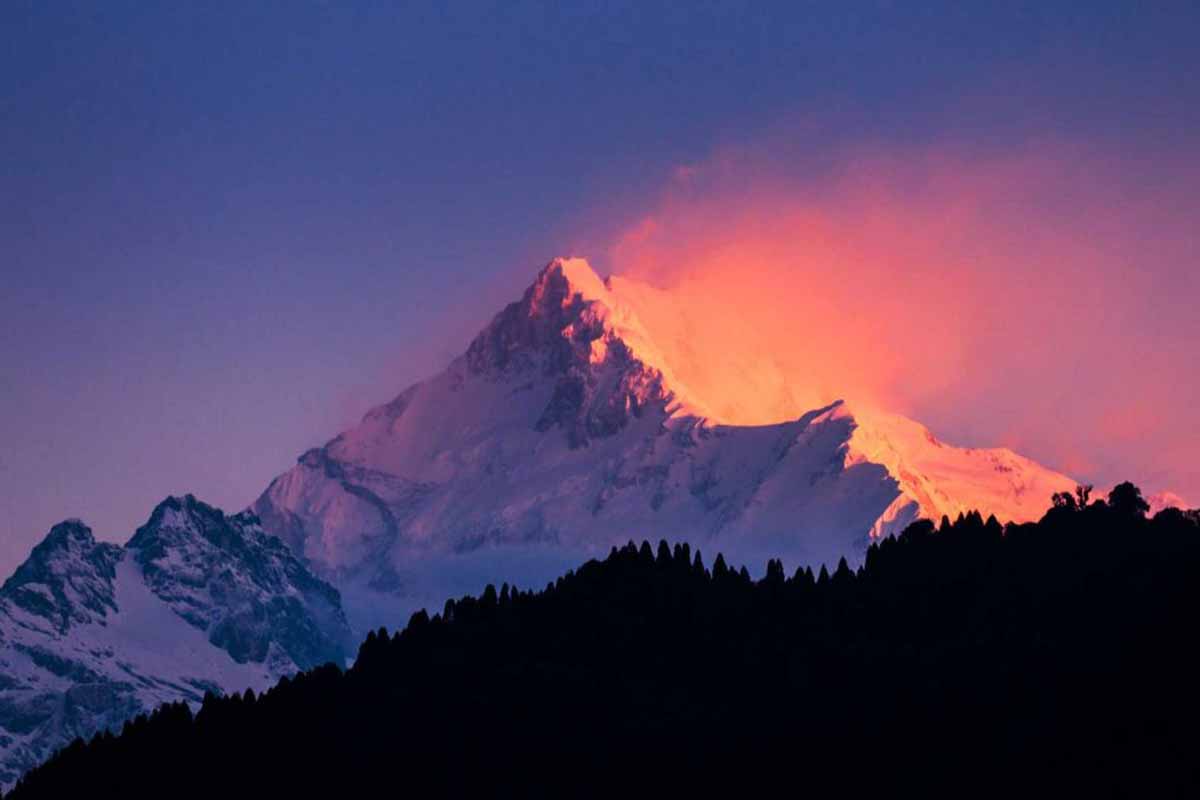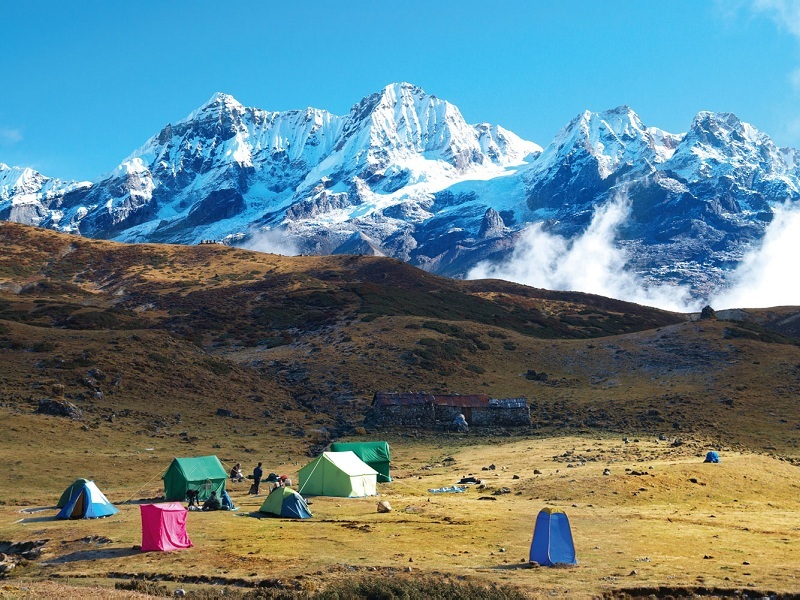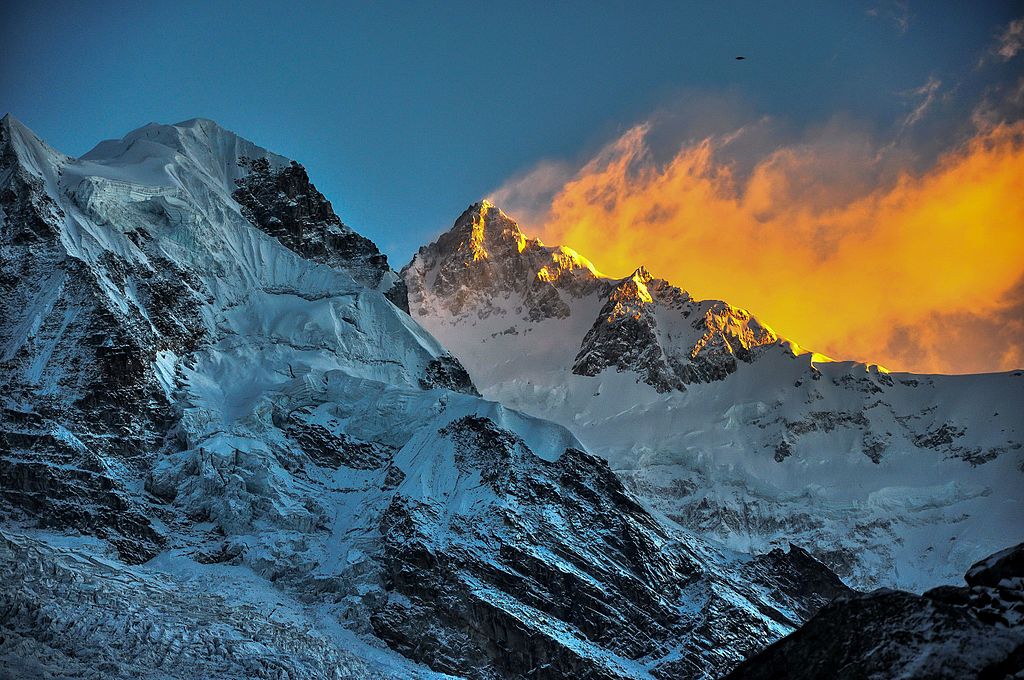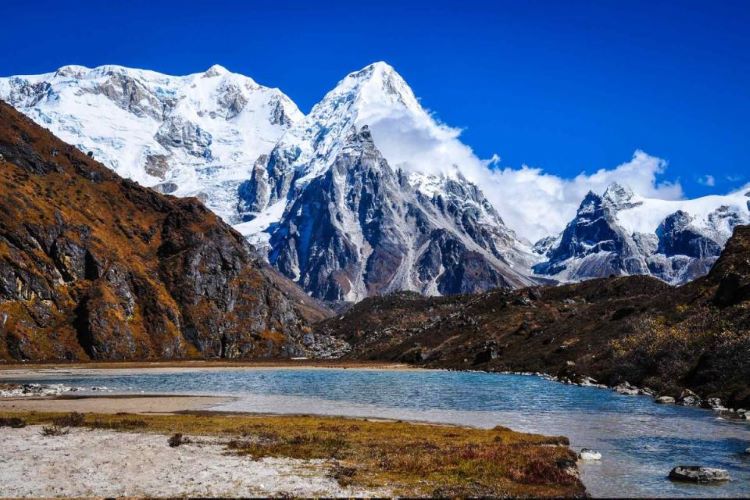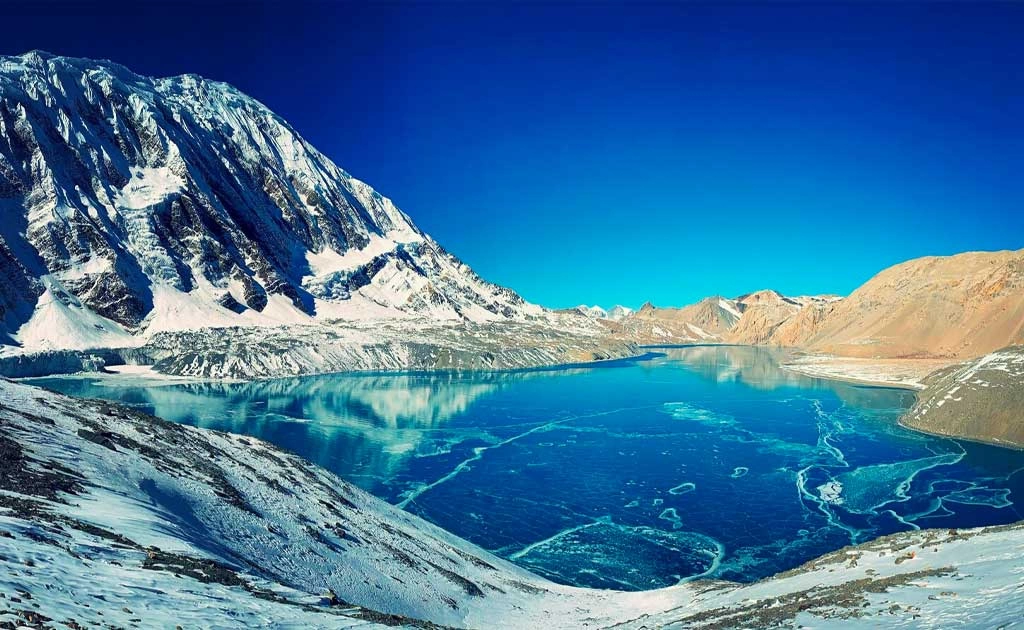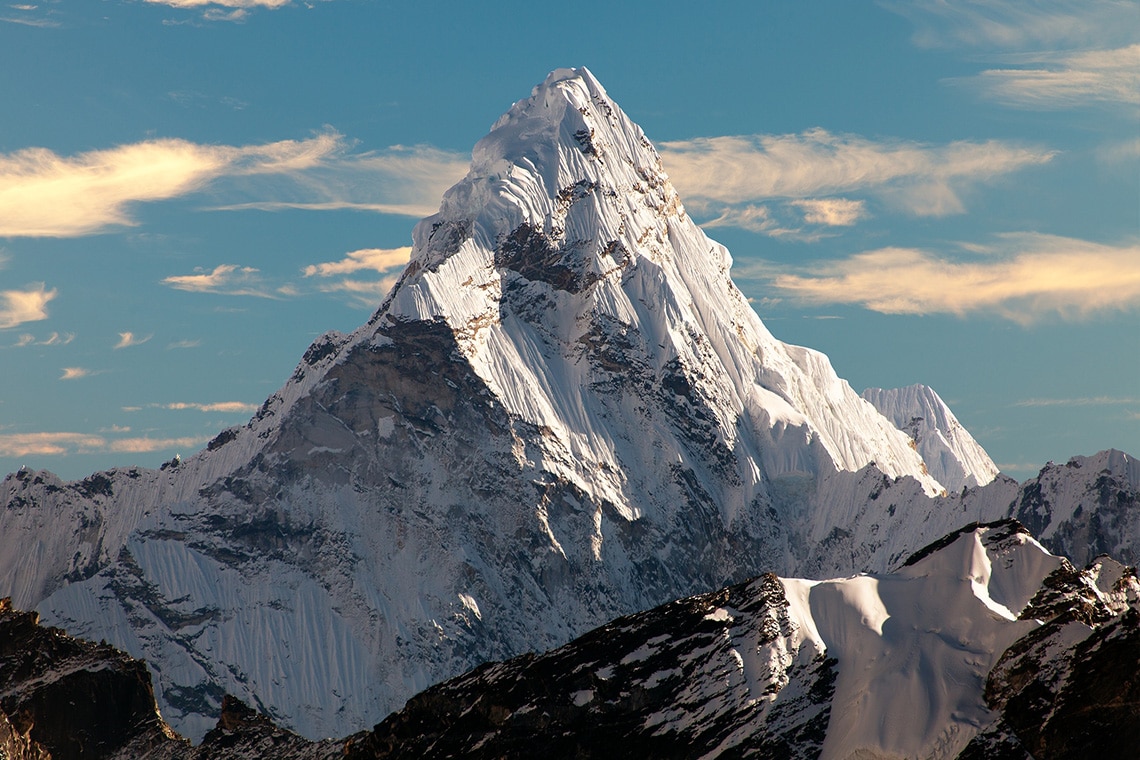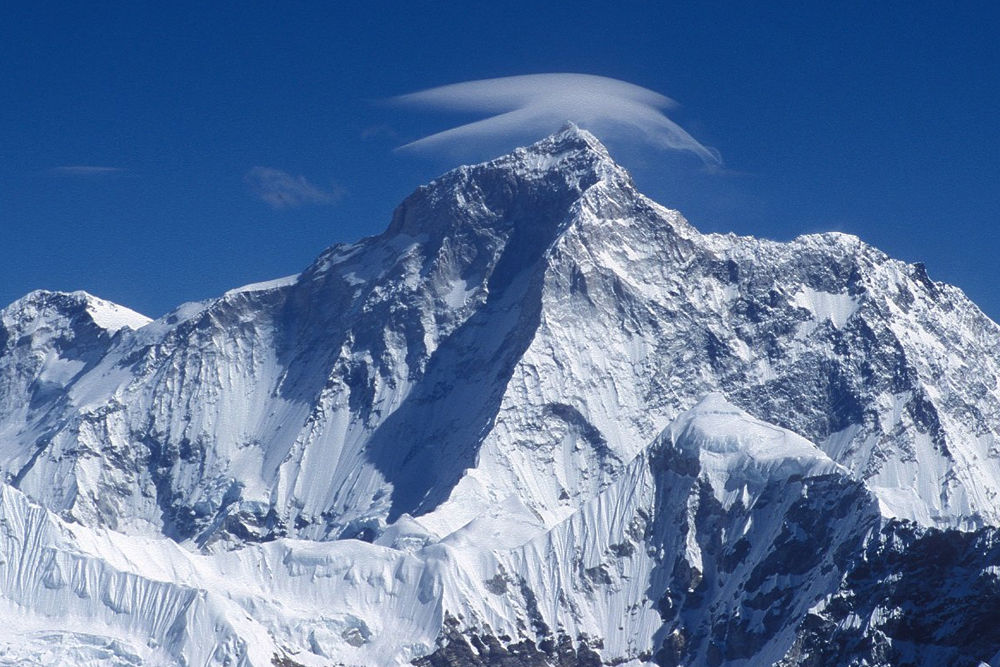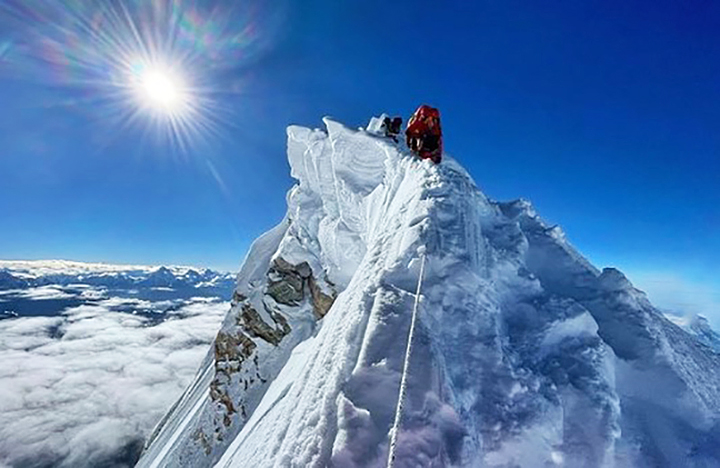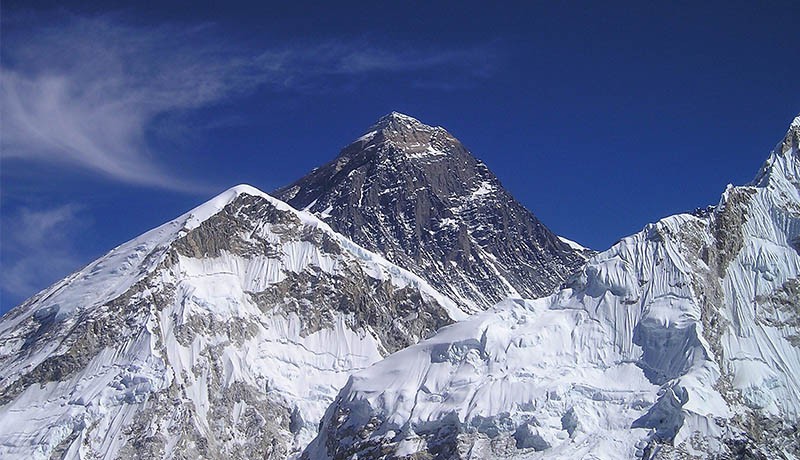Trip Facts
Highlights
- Stunning Scenic Views
- Cultural Immersion
- Challenging Climb
- Rich Biodiversity
- Historical and Spiritual Significance
- Base Camp Experience
Overview
The second highest Himalaya peak of Nepal and third after Mt. Everest and Mt. K2 in the world, Mt. Kanchenjunga (8586m) is located in the eastern part of Nepal. The name “Kanchenjunga” is delivered from the Tibetan word ‘Kanchen’ and ‘Dzonga’ translated means “The Five Treasures of the Great Snows”, as it contains five peaks, Kanchenjunga I (8586m), Kanchenjunga West (8505m), Kanchenjunga South (8494m) and Kangbachen (7903m). The treasures represent the five repositories of God, which are gold, silver, gems, grain, and holy books.
Kanchenjunga is located on the border between Nepal and Sikkim, and it is very remote attracting relatively few trekkers and therefore it retains much of its pristine beauty, mystery and charm. Mt. Kanchenjunga due to its beauty and size is considered a sacred by local Sikkimese people. With 4 ridges radiating in X pattern almost symmetrically from the main summit aesthetically Kanchenjunga is a beautiful mountain visible from many places with a famous view from Tiger Hill in Darjeeling, India.
Three of the five peaks (main, central, and south) in Kanchenjunga are on the border of North Sikkim district of Sikkim, India and Taplejung District of Nepal, while the other two are completely in Taplejung District. Nepal is home to the Kanchenjunga Conservation Area Project run by the World Wildlife Fund in association with Government of Nepal. The sanctuary is home to the Red Panda and other montage animals, birds and plants. India’s side of Kanchenjunga also has a protected park area called the Khangchendzonga National Park.
Kanchenjunga was assumed to be the highest mountain in the world until 1852, and only after the British Great Trigonometric Survey in 1849 Mt. Everest (known as Peak XV at the time) was crowned the highest and Kanchenjunga the third highest. Kanchenjunga was first climbed on May 25, 1955, by Joe Brown and George Band, of a British expedition team. As a respect to the beliefs of the Sikkimese, who hold the summit sacred, they are stopping a few feet short of the actual summit, and this has developed to a tradition followed by successful summit parties since then. Kanchenjunga is called Sewalungma in the local Limbu language, translates as ‘Mountain that we offer Greetings to’. Kanchenjunga or Sewalungma is considered sacred in the Kirant religion.
Kanchenjunga Expedition is an enormous mountain mass, and many satellite peaks rise from its narrow icy ridges. The Expedition is the most easterly of the great 8,000-meter peaks of the Himalaya. The climb is technical, even along the normal route but it is extremely interesting to climb with technical and intricate mixed rock and ice climb to the North Col followed by a not too technical steady 1500m ascent to the summit. The section past North Col in Kanchenjunga Expedition is exposed to the weather. The views are stunning both from the Base Camp as well as during entire climb of this Climbing Higher Peak.
In the Kanchenjunga Expedition, the west summit, Yalung Kang, is 8420m high and some people classify it as a separate 8000m peak. Three first Westerner to explore Kanchenjunga was the British botanist JD Hooker, who visited the area twice in 1848 and 1849. Exploration of the Skim, side of the peak continued with both British and pundit explorers mapping and photographing until 1899 in Kanchenjunga. In that year a party led by Douglas fresh field made a circuit of Kanchenjunga and produced what is still one of the most authoritative maps of the region. The Japanese now took up the challenge and mounted expeditions in 1973, 1974 and 1976 during which they climbed Yalung Kang. A German Expedition climbed Yalung Kang in 1975, and in 1977 an Indian army team mounted the second successful expedition to the main peak of Kanchenjunga.
Climbing Route
The access trek from Suketar to the Base camp is also interesting due to its remoteness, the cultures inhibiting the area and a very rare endemic flora with 30 varieties of rhododendrons and 69 varieties of orchids. In Kanchenjunga Expedition the North Face route is definitely the safest, although not the easiest. Climb of Kanchenjunga begin from a charming base camp in the meadows of Panorama at 5,180 m. First challenge is to fix lines up 900 m of intricate mixed climbing to the North col. This provides the most challenging climbing of the expedition. Once creating a lifeline to and from the North Col you can begin the long process of establishing three camps up the long and complicated North ridge. Using Sherpa support and oxygen, you can move at a systematically slow velocity higher and higher up the mountain. This is a highly satisfying climb for the expert Climbers.
Kanchenjunga Expedition Base Camp Service
- We provide very professional, supportive and friendly mountaineering logistic services from Kathmandu to the ABC as well as during the climb. Our objective is to ensure a good quality, supportive, safe, friendly, stress free and comprehensive service to maximize summit opportunity.
- We provide a comprehensive service organizing all necessary permits, and climbing documentation, travelling logistics including airfares, ground transportation, porters, and other individual services required by mountaineers. On the track to the ABC, we organize logistics for provision of all required accommodation and food.
- In the Base camp our cook and helpers will prepare and serve three delicious freshly cooked and plentiful meals a day and will ensure that hot and cold drinks are available 24hrs a day.
- In the Base Camp we provide spacious expedition quality personal tents for all our clients both with full board and base-camp service only.
- In the base camp we also provide dining tent, kitchen tent, toilet facilities and portable shower facilities and tent accommodation for our staff. We also have a comprehensive First Aid Kit available to our clients.
- In the Base Camp we provide access to communication including satellite telephone and internet access, and solar panels to charge your batteries.
Kanchenjunga Expedition Full Board Service
- For full board clients we provide personal tent and food, which will be prepared in high camps by their climbing Sherpa. We provide UHF/VHF handheld radios on the mountain to maintain communications between ABC and high camps.
- Full board with us means a provision of a personal climbing Sherpa to each individual climber, who will help the clients to reach the summit. Personal climbing Sherpa will set up camp 1, camp 2 and camp 3 and required bivvy including food provisions, fuel and oxygen and will guide and assist the client on the summit day. There are no commercial expeditions on Kanchenjunga so your climbing Sherpa with cooperation of other clients climbing Sherpas will set-up fixed ropes to North Col.
Approaches to ABC
- There are two Base Camps to climb Kanchenjunga, Kanchenjunga North Base Camp on Kanchenjunga Glacier and South Base Camp on Yalung Glacier. The access to both camps is from Suketar (2400m), the town with closest airport to the mountain with flights to Kathmandu. Suketar is also last town accessible from Kathmandu by the road. The route from North Base Camp via the North Col is the Normal route. It is not the easiest by it is the safest route with least objective danger.
- Kanchenjunga is the most remote of all 8000m peaks in Nepal, and the trek to the North Base camp from Suketar takes about 11 days along Ghunsa Khola valley; it is 80km long gradual hike from 900m to 5100m, so it is a very nice way to relax and acclimatize to start the climb on the strong foot. Suketar is located at 2400m, so first day is a long downhill of 1500m, which has to be climbed on the return way.
Climbing Routes
- The normal route via North Col and North face is definitely the safest but it is technical climbing. It will definitely not be suitable for an inexperienced climber, but it is a delight for technical climber. The scenery is phenomenal all the way from the Base Camp overlooking the Kanchenjunga glacier, Kanchenjunga I and Kang Bachen.
- The climb is challenging but very interesting. The most difficult section is to the North Col of about 500m of mixed ice and rock climb, where our climbing Sherpas will establish fixed rope route from just above 6500m to 7000m on the Col, a beeline to take gear up safely. Once on the North Col the climb is along the ridge and the North face. The climb becomes less technical but very exposed to the weather.
- From the Col the climb is typically done with 3 camps or bivies moving up slowly to the summit.
Itinenary
Upon your arrival at the Tribhuvan International Airport, one of the Nomadways Adventure representatives will be waiting for you at the airport. As soon as you complete your Nepal Entry Visa obtaining procedure, we will have a meet and greet, and you will be transferred to the hotel (3-star to 5-star as per request) where you can rest and relax for the day.
Before we start our expedition, we will need to obtain the required permits for the Kanchenjunga Expedition. We will also prepare all our documents and go for last-minute shopping. At our Eight K Expeditions premise, we will conduct a short briefing about the expedition. Enjoy your day in Kathmandu and prepare to head out to a wonderful adventure experience.
We partake a warm breakfast in the morning. Then, we will drive to the airport to catch a short flight to Bhadrapur, a town in eastern Nepal. Then, we will drive to Illam, a beautiful and old market in the Eastern Region of Nepal. It is very popular for tea gardens and exports high-quality tea leaves around the world. We will explore around the Illam Bazaar and rest overnight in a hotel.
The next day, we will drive from Illam Bazaar to Jorpul via Phidim village. We will behold the pleasing sights of terraced farmlands, vegetations, tea gardens, and cardamom plantations as we move higher. We will finally reach Jorpul to rest overnight to release the pain due to the 9-10 hours drive.
Our trek starts from Jorpul as we slowly ascend towards Khebang through the lush green forests of Rhododendrons, Pines, Oaks, and Deodars. After a series of ascents and descents for about 5 hours, we will reach Khewang to rest overnight.
From Khewang, we walk along the Kabeli Khola and cross many streams over the suspension bridges. We start ascending through valleys, dense forests, and waterfalls. As we move from Subtropical to temperate regions, we will notice diverse vegetation and forest density.
Yamphudin is a village resided by people from diverse cultures and ethnicities. From there, we ascend towards Dhupo Bhanjyang and further to Lasiya Bhanjyang (3310 m). Then, we descend to Amji Khola and walk along until we reach Torongdin at 2995 m to rest overnight. This will be a very tiring day as we trek for almost 11 hours.
We start after breakfast at Torongdin and trek towards Tseram. As we slowly enter the subalpine zone, green trees are fewer and shrubs and wildflowers are abundant. We will be gaining subsequent height so we will spend a day in Tseram for acclimatization.
We will wake up for a warm breakfast and start our trek to Ramche. We will be crossing the Yalung Glacier moraine and beautiful lakes and meadows. After a 6-7 hours trek we will finally reach Ramche to rest overnight. At Ramche, our team will set up comfortable tents for us to sleep.
From Ramche, we start early as we will be elevating to the Middle Base Camp at 4900 m. The trail takes us through the glacier moraines and rugged path until we reach the Middle Base Camp in the meadows.
Following the glaciers of the northern ridge, we will hike up to the base of Kanchenjunga Base Camp and set up our tents. We will be welcomed by the panoramic views of giant snow-capped mountains including the mystic Mt. Kanchenjunga.
We will allocate 26 days of our trip for the climbing period of Mt. Kanchenjunga. During this course, we will conduct multiple rotations around the higher camps. We will allocate enough days for acclimatization as it is extremely important to adapt to rarefied air of high altitude. Frequent rotations in between upper camps and basecamp will be our key strategy for acclimatizing. Most of the climbing will be done over the snow, ice, and glaciers so we will train with an ice ax, crampons, and ladder climbing before heading to the summit. The last part involves climbing on a steep horizontal rocky section. We will climb up to a step short of the main summit, as it is considered pious and sacred.
As we reach the top, we will be gifted with the vistas of Mt. Lhotse, Mt. Everest, Mt. Makalu, the Kanchenjunga massif, and other giant snow-capped peaks.
We will then return to the lower camp and prepare to leave.
After a successful ascent to the third highest peak of the World, we return to the base camp and pack up our expedition logistics. We then clean up the base camp and prepare to leave.
We retrace our path back to Ramche walking on the rugged terrain for 9 hours. We then rest overnight in a lodge or a tented camp.
Our trek starts from Ramche and we reach Tseram for lunch. We then walk through the forests down to reach Torongdin to rest overnight.
Our trek continues to descend back to Yamphudin until we reach our lodge to rest overnight.
We start early after breakfast and resume our trek to Jorpul. We will cross the Khebang village and continue towards Jorpul. The total trekking hours will be about 9-10 hours.
Our trek ends at Jorpul, from where we take a private vehicle to reach the commercial city Birtamod. We will rest at a very comfortable hotel in Birtamod.
After a night’s rest in Birtamod, we will drive back to Kathmandu. You may choose to take a flight as well at some extra costs. Upon our arrival in Kathmandu, you will be escorted to the hotel to rest and relax.
This leisure day is for you to explore Kathmandu city. You can go sightseeing to different World Heritage Sites like Bouddhanath Stupa, Swayambhunath Temple, Pashupatinath Temple, Patan Durbar Square, Bhaktapur Durbar Square, Basantapur and Thamel areas, and many more. In the evening, we will all meet for a wonderful farewell dinner at a typical restaurant.
If you have not booked any other packages or extended your holiday/stay in Nepal, one of our representatives will drop you off at the airport for your departure to your home country. We will look forward to traveling with you again.
Cost Includes:
- All airport transfers
- Luxury Hotel in Kathmandu for two nights with breakfast
- All necessary paperwork and trekking permits (National Park permit and TIMS)
- An experienced English-speaking Govt. registered trekking guide and local porters to carry luggage (2 trekkers: 1 porter)
- Full meals: Breakfast, Lunch & Dinner of your choiceFull meals: Breakfast, Lunch & Dinner of your choiceFull meals: Breakfast, Lunch & Dinner of your choiceFull meals: Breakfast, Lunch & Dinner of your choiceFull meals: Breakfast, Lunch & Dinner of your choice
- Full meals: Breakfast, Lunch & Dinner of your choice
- Supplementary snacks: energy bar and cookies
- Seasonal fresh fruits desert every day
- Unlimited Chlorine treated Safe Drinking water
- Accommodation: Lodge
- A comprehensive First Aid kit
- Oxi-meter: To check heart rating and oxygen saturation to Everest Base Camp and return
- All government and local taxes
- Trekking equipment: down-filled sleeping bag, walking poles, and duffel bag
- Souvenir: Trekking Route map printed T-Shirts
Cost Excludes:
- Lunch and dinner in Kathmandu
- Hot and bottled drinks
- Electronic device re-charge Wi-Fi
- Travel insurance and medical evacuation
- Tipping
- Hot shower
Equipment
Trekking requires careful selection of gear to ensure comfort, safety, and efficiency on the trail. Depending on the conditions (terrain, weather, duration), the equipment you need may vary, but here’s a comprehensive list of essential trekking gear:
- Backpack
- Capacity: Typically, for a multi-day trek, a 40-60L pack is ideal.
- Fit: Adjustable straps for shoulder, chest, and hip.
- Features: Hydration system compatibility, side pockets for easy access, and a rain cover.
- Footwear
- Trekking Boots: Look for boots with good ankle support, durable soles (Vibram is a popular choice), and waterproof features.
- Trail Shoes: For lighter treks or well-maintained paths, trail shoes may suffice.
- Sock Layers: Merino wool socks or synthetic socks that wick moisture and reduce blisters. Avoid cotton.
- Gaiters: To keep debris, mud, and snow out of your boots.
- Clothing (Layering System)
- Base Layer: Moisture-wicking (synthetic or merino wool) long-sleeve top and bottoms.
- Mid Layer: Insulating layer, such as a fleece or down jacket.
- Outer Layer (Shell): Waterproof, windproof jacket and pants. Gore-Tex or similar fabrics are excellent choices.
- Trekking Pants: Convertible pants (with zippers for shorts) can be useful.
- Trekking Shirt: Lightweight, moisture-wicking, and quick-drying.
- Gloves: Lightweight gloves for warmth, plus an additional heavier pair if trekking in cold climates.
- Hat/Cap: A sunhat or beanie depending on the weather.
- Neck Gaiter/Buff: For sun protection, warmth, or dust.
- Sleeping Gear
- Sleeping Bag: Temperature-rated for the conditions you’ll face. Down bags are warmer and lighter but lose effectiveness if wet, while synthetic bags dry quicker.
- Sleeping Pad: Inflatable or foam pads that insulate from the cold ground.
- Tent: Lightweight trekking tents (1-3 person) that suit your conditions. Some options include 4-season tents if you're trekking in harsh weather.
- Hydration System
- Water Bottles: Collapsible or hard plastic bottles (ensure they’re BPA-free).
- Hydration Reservoir: Camelbak or similar bladder systems for easy access to water.
- Water Purification: A filtration system (e.g., Sawyer, LifeStraw) or chemical tablets to purify water from streams or other sources.
- Food and Cooking
- Stove: Compact gas or alcohol stove for cooking on the trail.
- Cookware: Lightweight pots or pans, often titanium or aluminum.
- Fuel: Compatible fuel for your stove (check for availability in the region you’re trekking).
- Food: Dehydrated meals, energy bars, trail mix, nuts, and fruits. Lightweight, high-calorie, and easy-to-prepare foods are best.
- Navigation Tools
- Map and Compass: Always have a paper map as a backup, even if you use a GPS.
- GPS Device or Smartphone with a Trekking App: Make sure to download offline maps.
- Altimeter Watch (optional): Useful for tracking elevation and route progress.
- Lighting
- Headlamp: Hands-free lighting for night-time use, with extra batteries.
- Flashlight: A backup to your headlamp.
- First Aid Kit
- Include basic supplies: Bandages, antiseptic wipes, blister treatment, pain relievers, and any personal medications.
- Personal Medications: Always bring enough for the whole trip, plus extras in case of delays.
- Sunscreen and Lip Balm: Protect your skin from sun exposure.
- Safety Gear
- Multi-tool/Knife: A good multi-tool (like a Swiss Army Knife or Leatherman) is very useful for repairs and emergencies.
- Whistle: For signaling.
- Emergency Blanket: Lightweight and compact for warmth in case of emergency.
- Firestarter: Matches or a lighter, and waterproof if needed.
- Miscellaneous
- Trekking Poles: Help with balance, reduce strain on knees, and improve traction on uneven terrain.
- Towel: Quick-dry, compact towel.
- Sunglasses: UV protection for your eyes.
- Camera/Smartphone: For documenting the journey, with extra storage or a portable charger.
- Personal Hygiene and Toiletries
- Toilet Paper: Always carry biodegradable toilet paper and a small trowel for digging a "cathole" if there are no facilities.
- Hand Sanitizer: To keep clean without access to water.
- Wet Wipes: For cleaning yourself when there's no shower.
- Biodegradable Soap: If you need to wash, use eco-friendly soap.
- Toothbrush/Toothpaste: Compact travel versions.
- Weather Protection
- Sun Protection: Sunglasses, sunblock, and a wide-brimmed hat for sun protection.
- Rain Gear: A high-quality waterproof jacket, pants, and gaiters, especially if you're trekking in areas with unpredictable weather.
- Cold Weather Gear (if needed): Depending on the trek, you might need additional gear like down jackets, insulated gloves, or even crampons for ice or snow.
- High-altitude Treks: Consider gear for altitude sickness (like Diamox), extra layers for extreme cold, and an oxygen system if necessary.
- Long-distance Treks: You might need additional gear like extra food storage, a larger stove, or a lightweight trekking umbrella.
FAQ's
Mt. Kanchenjunga, the third-highest mountain in the world at 8,586m, is located in the eastern Himalayas along the border between Nepal and Sikkim (India).
The standard Kanchenjunga expedition typically spans 56 days, including acclimatization, preparation, climbing, and return.
Climbers must have excellent physical fitness, endurance, and prior experience with high-altitude mountaineering. Strength, cardiovascular endurance, and mental resilience are critical.
